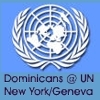

| BRIEFING - July 16, 2014 | To learn more about the Millenium Development Goals, click on the graphic Read the summer 2014 “Dominicans at the UN” newsletter Past Briefings: July 2, 2014 June 18, 2014 June 4, 2014 May 7, 2014 April 9, 2014 March 19, 2014 March 5, 2014 Feb 19, 2014 Jan 8, 2014 Nov 22, 2013 Oct 23, 2013 Oct 9, 2013 Sept 25, 2013 Sept 11, 2013 July 10, 2013 June 26, 2013 June 12, 2013 May 8, 2013 April 24, 2013 |
|
Signs of the Earth’s degradation: Do we care? I am currently reading a book entitled “Spiritual Ecology: The Cry of the Earth,” a collection of essays edited by Llewellyn Vaughan-Lee. In the contribution offered by Chief Oren Lyons of the Onondaga Nation, the chief reflects on the wisdom his people received a long, long time ago in prophecies—namely, that there would be a degradation of Earth. The Onondaga were told that two very important signs would warn them of the extent of this degradation. One would be the acceleration of the winds. “When you see that the accelerations of the winds are growing, then you are in dangerous times.” The other way to tell the extent of Earth’s degradation would be in the way people treated their children. “So when you open up the newspapers today, they talk about exploitive sex and children, they talk about homeless children… To us, it’s a severe indication of the degradation. Society doesn’t care.” I couldn’t help but reflect on the truth of this Native American intuition in light of growing concerns about global climate change, and the seemingly unending stream of undocumented children crossing the U.S.-Mexico border. Massive wildfires on the West Coast, an unprecedented number of tornadoes throughout the nation’s heartland, and torrential downpours along the East Coast are all indicative of the accelerations of the winds. And the treatment of children, many of whom are unaccompanied, by the intransigent U.S. Congress give credence to the Onondaga’s received prophecies. In the chief’s words, it would seem that “Society doesn’t care.” The vast majority of these child migrants come from Honduras, El Salvador and Guatemala, an area which has become one of the most violent regions on earth. These countries struggle with levels of violence which have been described as tantamount to an undeclared regional war. (“‘Flee or die’: violence drives Central America’s child migrants to U.S. border,” The Guardian, July 9, 2014). The New York Times addressed this tragic situation last Sunday (“The Children of the Drug Wars: A Refugee Crisis, Not an Immigration Crisis,” July 13, 2014), highlighting Honduras, which has been plagued by gang violence and foreign drug cartels. Honduras, a primary transit point for U.S.-bound cocaine, has the world's highest homicide rate for a nation that is not at war. A permanent solution to this dilemma would be to deal with the root causes of violence in Honduras itself, as well as the insatiable demand for illegal drugs here in the United States, which helps to fuel the violence which these children are fleeing. In a very real sense, the children on our border could be considered refugees fleeing armed conflict and fear of persecution. Just this past week, the United Nations High Commissioner for Refugees urged both the United States and Mexico to consider them as such, and not simply send them back into the sea of violence which they fled. In its Sunday, July 13, editorial, The New York Times states, “Smugglers are profiting mightily from the fear that propels children north and the fear that locks our country down. Republicans are feeding the cycle, stoking panic about a border assault, even to the point of demanding that President Obama call out the National Guard… The besieged border is a myth, and the arrival of a few thousand weary children in buses does not make the myth true.” At a press conference last week, House Speaker John Boehner insinuated that the crisis of unaccompanied children on the U.S. border was the fault of the president. The speaker said, “He’s been president for five and half years! When is he going to take responsibility for something?” Is this a stunning example of projection? Congress has been the major obstacle to any meaningful immigration reform, which is all the more reason for us to do whatever we can to keep the pressure on Mr. Boehner and our elected representatives to rise above partisan politics and craft legislation which will deal with immigration in a comprehensive and compassionate manner. Let me conclude by referencing another essay from the book “Spiritual Ecology.” In addressing the evolutionary crisis of the human spirit, the authors (John Stanley and David Roy) refer to the ego-self, characterized by what Albert Einstein called the “optical illusion of separateness.” They go on to suggest that the key point of the evolutionary crisis of the human spirit is that we can no longer afford to be limited by this illusion. We have to come to the realization that our original self includes the whole living world. “That kind of empathy, based on a holistic worldview, is essential. Without it we will not survive the ecological and social “great unraveling” that has already begun.” Imagine what might happen if Mr. Boehner and members of Congress were able to see the children on the border not as collateral damage of what they might term failed immigration policy, but rather as “our children?” It would seem that we have our work cut out for us…
|
Dominican Leadership Conference
Building relationships and collaborating in the mission of preaching the Gospel
29000 West Eleven Mile Road
Farmington Hills MI 48336
248-536-3234 Contact: Executive Director

